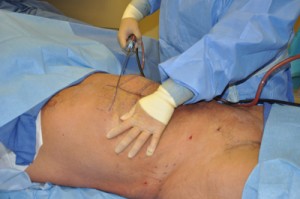Fat cells are well known to release a large of cytokines (adipokines) that help regulate energy homeostasis and overall body fat mass. (leptin, tumor necrosis factor and many others) Leptin, for example, is a hormone produced by fat cells to help regulate body energy balance. Higher levels of leptin release favors energy burning rather than storage. Bigger fat cells release higher amounts of leptin than smaller fat cells which tell the brain to have one stop eating and burn more energy. But in the obese patient their brain is more resistant to this leptin message and is one reason they may continue to gain weight or can’t keep it off.
Conversely, smaller fat cells send out very low levels of leptin telling the brain to store energy rather than use it. This simplistic hormonal science would lend support to the fat cell homeostasis concept which in the liposuction patient could mean that removing large amounts of fat cells and mass, with resultant less circulating leptin, may be inadvertently inducing the body to try and put the fat back. However, whether the brain/body responds to fat cell number loss by increasing preadipocyte conversion and/or differentation in an attempt to maintain the fat mass it had is still a theoretical response.
While these fat cell behavior concepts seem straightforward and a bit contradictory, the variability of body type and fat mass must surely play a role in how these body fat responses are played out. If one divides body types into five main groups (lean, average, overweight, obese, extremely obese), it is clear that a change in body type is associated with a similar change in fat cellularity. (one who is obese has bigger fat cells than one who is lean and most likely has more fat cells as well) Research has clearly shown that obesity presents with different types of cell changes with severe obesity having increased numbers of fats as well as a fat cell size problem.

While subcutaneous fat makes up about 80% of all body fat, it is suspected that it is not all the same. The fat around the abdomen and waistline is clearly more of a depot type fat than that of the neck or knees for example. (metabolic diversity) Fat accumulations occur in the abdomen either first or preferably in unfavorable energy balances. (the visceral intra-abdominal fat aside) Whether this is due to a greater number of fat cells per cm2 of tissue or a greater susceptibility to be stimulated for volume acquisition by increased receptors, or both, is not known. Such localized fat mass differences may account for why ‘liposuction may be more sustainable in some body areas than others’ once the cell numbers are decreased. For example, once the inner knees are reduced even in an obese patient, it is unusual to ever see much if any accumulation later. Certainly the same can not be said for subcutaneous abdominal fat removal.
In search of addressing the simple question of whether fat will return after liposuction…our current understanding of fat cell biology does not permit a clear biologic answer. That may not be satisfying to a prospective patient but is reflective of what we currently know. Current fat cell science suggests that:
Liposuction should not be viewed as a permanent or lifelong body contouring procedure. One may or may not get years of aesthetic benefit from localized removal of fat but the factors contributing to its long-term sustainability are not yet known.
It is sound biologic advice to maintain one’s weight after liposuction. This is the best way to prevent a subsequent increase in fat cell volume.
Liposuction works best in near weight appropriate individuals both in visible changes and in a greater likelihood of a sustained result. When a plastic surgeon tells a patient to lose some weight (or be within 20% of less of their ideal body weight) before being a good candidate for liposuction, that advice has some biologic merit and is in the patient’s best interest.
Obese individuals appear to be a biologic setup for a complete relapse for fat re-accumulation, most likely quicker than in a lean or weight appropriate individual.
Fat reaccumulation after liposuction, when and if it does occur, may develop from whence it was removed or may have tendency to occur elsewhere. This appears to vary by the individual. It is does not exclusively occur one way or the other and there is no scientific evidence that it does.
Dr. Barry Eppley
Indianapolis, Indiana


